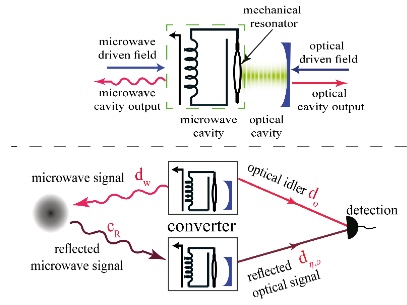Quantum radar could detect stealth cancer cells or aircraft
February 27, 2015

(a) Schematic of the electro-opto-mechanical (EOM) converter in which driven microwave and optical cavities are coupled by a mechanical resonator. (b) Microwave-optical quantum illumination using EOM converters. The transmitter’s EOM converter entangles microwave and optical fields. The receiver’s EOM converter transforms the returning microwave field to the optical domain while performing a phase-conjugate operation. (credit: Shabir Barzanjeh et al./ Physical Review Letters)
A prototype “quantum radar” that has the potential to detect objects that are invisible to conventional systems has been developed by an international research team led by a quantum information scientist at the University of York.
The new breed of radar is a hybrid system that uses quantum correlation between microwave and optical beams to detect objects of low reflectivity such as cancer cells or aircraft with a stealth capability. Because the quantum radar operates at much lower energies than conventional systems, it has the long-term potential for a range of applications in biomedicine, including non-invasive nuclear magnetic resonance (NMR) scans.
The idea is to use “quantum illumination” to “interrogate the target region with one optical beam while retaining its entangled counterpart for subsequent joint measurement with the light returned from that target region,” the researchers explain in a paper in Physical Review Letters.
Quantum illumination has only been demonstrated at optical wavelengths, but the research team, led by Stefano Pirandola of the University’s Department of Computer Science and the York Centre for Quantum Technologies, found that a special converter — a double-cavity device that couples the microwave beam to an optical beam using a nano-mechanical oscillator — was the key to enabling the concept to work at microwave frequencies.
The device can either generate microwave-optical entanglement (during signal emission) or convert a microwave signal into an optical beam (during the collection of the reflection beams from the object).
Detecting invisible objects in noisy environments
A conventional radar antenna emits a microwave signal to scan a region of space. Any target object would reflect the signal to the source but objects of low reflectivity immersed in regions with high background noise are difficult to spot using classical radar systems. In contrast, quantum radars exploit quantum entanglement to enhance their sensitivity to detect small signal reflections from very noisy regions.
Pirandola said that while practical quantum radars were some way off, they would have superior performance especially at the low-photon regime. “Such a non-invasive property is particularly important for short-range biomedical applications. In the long term, the scheme could be operated at short distances to detect the presence of defects in biological samples or human tissues in a completely non-invasive fashion, thanks to the use of a low number of quantum-correlated photons.
“Our method could be used to develop non-invasive NMR spectroscopy of fragile proteins and nucleic acids. In medicine, these techniques could potentially be applied to magnetic resonance imaging, with the aim of reducing the radiation dose absorbed by patients.”
Pirandola was funded by the Leverhulme Trust and the Engineering and Physical Sciences Research Council.
Abstract for Microwave quantum illumination
Quantum illumination is a quantum-optical sensing technique in which an entangled source is exploited to improve the detection of a low-reflectivity object that is immersed in a bright thermal background. Here we describe and analyze a system for applying this technique at microwave frequencies, a more appropriate spectral region for target detection than the optical, due to the naturally-occurring bright thermal background in the microwave regime. We use an electro-opto-mechanical converter to entangle microwave signal and optical idler fields, with the former being sent to probe the target region and the latter being retained at the source. The microwave radiation collected from the target region is then phase conjugated and upconverted into an optical field that is combined with the retained idler in a joint-detection quantum measurement. The error probability of this microwave quantum-illumination system, or quantum radar, is shown to be superior to that of any classical microwave radar of equal transmitted energy.